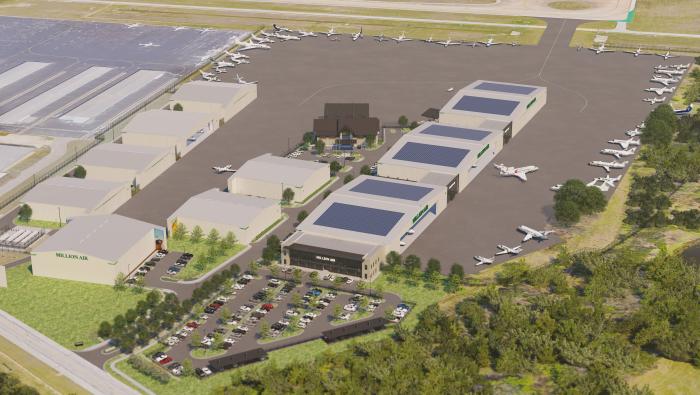
Pilots Edward Murphy and Ian Hofmann had just 75 seconds between the first indication of trouble with their Bombardier Challenger 604’s GE Aviation CF34-3B engines and crash landing on a highway in Naples, Florida, on Feb. 9, 2024, according to a trove of documents released late on Friday by the NTSB. The first of three master caution warnings—left engine oil pressure—was recorded at 15:09:33 EST, followed by the same warning for the right engine one second later, and an engine warning six seconds later.
It took the crew an additional 20 seconds, at 15:10:05, to realize both engines stopped producing power while the airplane was at about 1,000 feet msl and 122 knots on a shallow intercept angle for final approach to Naples Municipal Airport (KAPF). The crew then transmitted to tower, “…lost both engines…emergency…making an emergency landing.” The tower controller cleared the airplane to land, but the crew replied, “…we are not going to make the runway.”
The twinjet touched down on I-75 South at approximately 15:10:47. According to dashcam video, the Challenger then veered into the right grass shoulder before hitting a concrete sound barrier and catching fire.
Murphy and Hofmann perished in the accident, but the cabin attendant and two passengers survived. The air charter—operated under Part 135 by Fort Lauderdale, Florida-based Hop-A-Jet—originated at Ohio State University Airport (KOSU) in Columbus, Ohio, and was a supplemental lift flight for NetJets.
|
The flight attendant aboard the Bombardier Challenger 604 that crashed near Naples, Florida, in February 2024 helped passengers escape the burning aircraft by forcing open the baggage compartment door, an act that proved decisive after other exits failed. Both pilots were killed in the crash, but all three occupants—attendant Sydney Ann Bosmans and passengers Aaron Baker and Audra Green—survived.
Bosmans’ last-minute seat change from the jump seat after noticing the pilots had engine issues and her knowledge of how to open the luggage hatch, despite no formal training on how to do so, likely saved lives after the crash, as outlined in the NTSB documents detailing the accident. She recalled following training protocol from AirCare International’s FACTS as best she could even as the Challenger’s cabin filled with smoke. Bosmans told the NTSB in a post-crash interview that she knew that she’d be in a better position to brace and then to assess conditions outside the aircraft on the ground by sitting in a rear passenger seat.
After the impact, Bosmans was unable to open the cabin and overwing exits, which left the aft baggage compartment. After clearing items that were blocking the door, she was able to get it open, and the three exited and moved away from the aircraft.
|
In an interview with Hop-A-Jet pilot Anthony Donato, who is also an A&P mechanic with inspection authorization, and analysis of historical data, the NTSB has documented a hung start problem in the engines of the Challenger 604 that lost power and crashed in Naples, Florida.
According to the NTSB docket, 25 days prior to the accident, “a series of hung engine starts were recorded by the FDR [flight data recorder]. There were 10 hung starts in total between the two engines, with one successful start on engine 1 occurring during these start attempts.”
The NTSB explained, “A hung start, also known as a hot start or stagnated start, is defined as a start attempt that experiences a light off but does not then successfully continue to a self-sustaining idle speed before engine ITT [interstage turbine temperature] exceeds the start redline. Hung starts may be caused by a variety of factors, including weak starter performance, premature starter deactivation, a degraded or damaged compressor, incorrect scheduling of bleeds or compressor variable geometry, or bad fuel.”
In comparing the hung starts to the FDR data from the accident, the NTSB wrote, “the engines’ fuel and ITT behavior during the event flight was consistent with the behavior of the engines during the hung start rollbacks.”
|
The Canadian Business Aviation Association (CBAA) has submitted five recommendations to the federal government ahead of an upcoming budget discussion, intended to safeguard what CBAA recognizes as “a critical driver of Canada’s economy and a strategic asset for national growth.” These measures, it believes, will maximize economic benefits afforded by business aviation and “align with federal objectives on innovation and competitiveness.”
Totaling some 1,500 aircraft, Canada’s business aviation fleet generates an annual $17.9 billion in total economic impact. To support this driver of the country’s economy, CBAA’s proposals include removing the luxury tax on aircraft (enacted in 2022) and encouraging fleet renewal, underpinned by heightened awareness of the sector’s economic significance.
By mirroring U.S. policy allowing 100% first-year depreciation for qualifying business aircraft, Canadian operators and manufacturers would no longer suffer “a competitive disadvantage,” suggested CBAA.
With Canadian aerospace manufacturing exports worth more than $13 billion in 2024, this “world-class aerospace manufacturing cluster” must be supported “even as protectionist headwinds rise,” CBAA added. The group also recognized domestic production as “indispensable to U.S. and global OEM supply chains.”
Other suggestions include the formation of a new Transport Canada working group to support evolving business aviation regulations and improve safety reporting. The reduction of airport fees for business aircraft would also boost interprovincial trade expansion, aligning with the Canadian government’s goals.
|
Sponsor Content: Million Air
Million Air Austin broke ground on the company’s Phase II expansion, bringing exciting new facilities and amenities to one of the region’s most in-demand FBOs
|
Business aircraft flight activity in North America logged its highest year-over-year (YOY) gain of 2025 thus far in August, up by 4.4% as global activity increased overall by 3.7%, according to Argus International’s latest TraqPak report. Flight activity in Europe, meanwhile, marked its fourth positive month in a row, up by 1.9%. Argus predicts the YOY increase will continue in September at a more muted pace of 2.1% in North America and a slightly heated clip in Europe at 2.9%.
Activity in North America was expected to increase by 2.0% last month, Argus noted. The continued strengthening comes as fractional operations surged, with a 12.5% YOY gain. Part 135 operators flew 3.7% more YOY in August and Part 91 by 1.7%.
Midsize jet utilization saw the largest increase in the month with 5.4% more activity, but the fellow jet categories of small and large cabins were closely on the heels, climbing 5.3% and 5.2%, respectively. Turboprop activity increased by 2.2% in August. Large-cabin fractional operations posted the single largest improvement with a 24.7% gain.
In Europe, large-cabin jet activity took a significant jump upward YOY in August, rising 6.9%, while small-cabin activity increased by 1.1% and midsize jets by 0.6%. These offset the 2.6% decline in turboprop flights. As for the rest of the world, business aircraft flight activity improved by 2.5%.
|
Tamarack Aerospace has announced an expanded collaboration with operational and flight-planning software provider ForeFlight to deliver higher-resolution performance data for Active Winglet-equipped Citations. The expanded datasets are designed to provide operators with improved accuracy for fuel burn, time en route, and overall performance planning.
The rollout begins with Cessna CJ2 and CJ2+ operators, with subsequent phases to include the Cessna 525 series (CJ, CJ1, CJ1+, M2, and M2 Gen2) and the 525B series (CJ3, CJ3+, and CJ3 Gen3). ForeFlight users will see the updated profiles appear automatically as the phased rollout progresses.
Building on Tamarack’s global fleet of more than 200 upgraded Citation CJs, the integration incorporates thousands of operational hours into ForeFlight’s planning platform. According to Tamarack president Jacob Klinginsmith, the additional datasets refine the already FAA-approved and certified profiles. “These updates ensure that ForeFlight users have access to the most refined and comprehensive data available,” he said. “Our goal is to continuously improve operator confidence and maximize the benefits of Tamarack technology.”
Tamarack’s Active Winglets are designed to improve aircraft efficiency and sustainability, delivering up to 33% fuel savings, extended range, enhanced climb performance, and increased safety margins. Load alleviation technology featured in the patented system typically eliminates the need for the structural reinforcement required by traditional winglets.
|
NBAA is surveying its members to assess any concerns they have regarding the use of drones. Announced late last week, the survey also seeks viewpoints on the FAA’s recent notice of proposed rulemaking (NPRM) covering Part 108 beyond visual line of sight operations for uncrewed aircraft systems.
The survey will remain open until September 15 and, according to NBAA v-p for air traffic services and infrastructure Heidi Williams, member comments will help to inform the business aviation group’s response to the proposals. Industry stakeholders have until October 6 to provide input for the NPRM. The agency's proposal covers operating rules for drone package deliveries and missions including agricultural support, surveying, public safety, and for-hire flight testing.
“It is helpful to understand if members are using drones as a tool or if they have concerns with the proposed rule and drone operations,” Williams said. “Understanding the use and operational impacts will help form the basis of NBAA’s comments to the FAA on the proposed Part 108 rule. Commercial operations have been limited to either line-of-sight, or you’re operating under exemptions or waivers. The proposed rule opens the door to having routine and scalable operations, so we need to make sure it’s done right.”
|
TAT Technologies, which specializes in aircraft environmental control systems for civil and military aircraft, has opened an innovation center in Charlotte, North Carolina. Dubbed FutureWorks, the facility serves as a research and development hub for next-generation thermal management systems in traditional aircraft and advanced air mobility vehicles.
Announcing the facility’s establishment on September 3, TAT said it has already secured its first customer partnership for the next-generation thermal management systems, which it is designing to be lightweight and highly efficient. Engineers at the FutureWorks facility will focus on researching, testing, and developing thermal management systems and heat exchangers for electric, hybrid, and hydrogen-powered aircraft.
“FutureWorks represents our commitment to shaping what’s next for aerospace,” said TAT CEO Igal Zamir. “This lab is more than a building—it’s a proving ground for ideas, a collaboration hub for our global partners, and a launchpad for technologies that will define the skies of tomorrow.”
The facility features a high-voltage testing lab for thermal systems and has advanced capabilities to accelerate product validation and development, according to TAT. Although the facility has officially opened, it will not reach full operational capacity for a few more months. A formal grand opening ceremony is expected to take place in November.
|
AVIATION SAFETY QUESTION OF THE WEEK
Consider an aircraft in a power off descent, flying at the speed for maximum gliding range. What effect would weight reduction have on that gliding range?
- A. Gliding range increases.
- B. No effect.
- C. Gliding range decreases.
- D. Answers A and C are correct, depending on whether the aircraft powerplant is piston or jet.
|
Join us for lunch on Wednesday, October 15, at NBAA-BACE in Las Vegas to hear from a distinguished panel of leaders in business aviation to explore the future of in-flight connectivity. This exclusive event will feature key updates, highlighting innovations that are shaping the passenger experience and operational capabilities in the skies. Seating is limited. Sponsored by Honeywell Aerospace and Viasat.
|
RECENT ACCIDENT/INCIDENT REPORTS
September 6, 2025
Dallas, Texas United States |
- REPORT TYPE: Preliminary
- INCIDENT TYPE: Incident
- ACCIDENT REGISTRATION #: N560RT
- MAKE/MODEL: Cessna Citation V
September 4, 2025
Boca Raton, Florida United States |
- REPORT TYPE: Preliminary
- INCIDENT TYPE: Incident
- ACCIDENT REGISTRATION #: N776CJ
- MAKE/MODEL: Bombardier Challenger 300
September 3, 2025
Prospect Heights, Illinois United States |
- REPORT TYPE: Preliminary
- INCIDENT TYPE: Nonfatal
- ACCIDENT REGISTRATION #: N1927G
- MAKE/MODEL: Gulfstream G150
September 1, 2025
Round Mountain, Texas United States |
- REPORT TYPE: Preliminary
- INCIDENT TYPE: Nonfatal
- ACCIDENT REGISTRATION #: N36RP
- MAKE/MODEL: Sikorsky S-76D
August 29, 2025
Dallas, Texas United States |
- REPORT TYPE: Preliminary
- INCIDENT TYPE: Incident
- ACCIDENT REGISTRATION #: N858ME
- MAKE/MODEL: Cessna Citation V
August 28, 2025
Madison, Wisconsin United States |
- REPORT TYPE: Preliminary
- INCIDENT TYPE: Incident
- ACCIDENT REGISTRATION #: N456SW
- MAKE/MODEL: Gulfstream G500
|
 |
|
AINalerts News Tips/Feedback:
News tips may be sent anonymously, but feedback must
include name and contact info (we will withhold name on request). We reserve the
right to edit correspondence for length, clarity, and grammar. Send feedback or
news tips to AINalerts editor Chad Trautvetter.
|
AINalerts is a publication of AIN Media Group, 214 Franklin Avenue, Midland Park, New Jersey. Copyright 2025. All rights reserved.
Reproduction in whole or in part without permission is strictly prohibited.
|
|

















